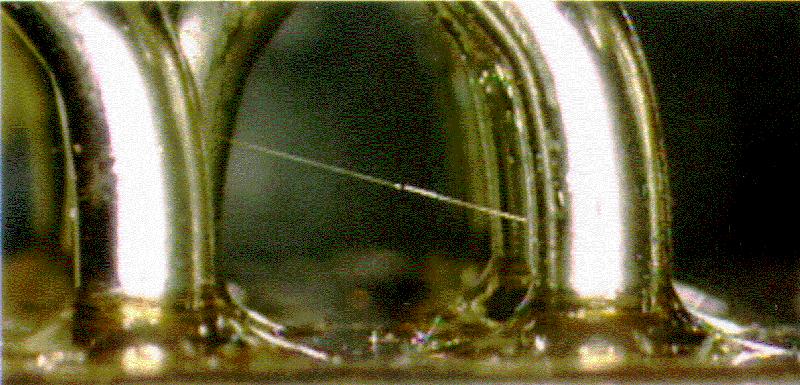Cosmic rays are not the only hazards that constantly threaten integrated circuits and chips. There are weird effects of pure metals “growing” or “dying” straight out of an alchemist’s manual that are equally dangerous. And like the danger of radiation, the smaller devices get, the more vulnerable they are to these peculiarities, and the harder it is to defend against them.
Tin whiskers may sound like what a fashionable robot’s mustache might be made of, but they are by no means decorative. They were first noticed back in the early Twentieth Century during the Golden Age of radio. Technicians noticed that tiny protruding tendrils could extend over time from the pure tin solders used in vacuum tubes. If they reached another soldered electrical connection, the whiskers could cause short-circuits, frying tubes, and causing general mayhem.
It was found that adding a little lead to the tin solders reduced this effect. But the 2006 European Restriction of Hazardous Substances Directive (RoHS), which has since become a default global standard, mandated the removal of lead wherever possible. Many chip makers switched to pure tin solders, and the problem came back. And, as chips are much smaller than tubes and the circuits are extremely close – just a few nanometers apart – so the danger of tin whiskers to digital devices is far worse. They’ve proven a real headache to NASA, which has done a lot of research on metallic whiskering.
Even stranger, tin can rot, that is, spontaneously corrode and crumble in low temperatures. “Tin pest” is the name given to this kind of grey corrosion that can spread to other tin surfaces by a mere touch, destroying the electrical conductivity of the metal.
Even before the RoHS, tin whiskers got blamed for the loss by unauthorized repositioning of the Galaxy IV telecommunications relay satellite in 1998. It suffered a processor failure which caused a loss of control of the spacecraft. They were also blamed for a false alarm that shut down a nuclear power plant in Connecticut in 2005, and were thought by NASA to be the best explanation for episodes of stuck accelerators in Toyota Camrys from 2005-2010.
Like radiation-caused failures, death by tin whiskers can be hard to determine. But it’s not just tin that’s the problem – whiskers can also form in pure lead, zinc, and even gold-plating. Zinc is a particular nuisance as whiskers can grow up to a millimeter a year, break off and become airborne, and thus cause shorts. Like tin, zinc is subject to corrosion, too, and zinc pest has consumed a countless number of cast-metal toys and antique buttons.
Not even gold is entirely safe. The noble metal is known to react with aluminum. It can form a low-electrical conductivity compound called “white plague” which can increase resistance, leading to circuit failure. Or aluminum and gold can create a bright-colored compound called “purple plague” or even “purple death”. Despite the name, the worst thing it does is eat away at the metals, forming voids.
Many efforts have attempted to prevent these problems. Altering the solder or electroplating chemistry on terminals can help reduce or even eliminate whisker formation. Coatings to block growth have also been used somewhat successfully, although in time, whiskers can pierce just about anything.
Traditional integrated circuit computers have just about reached the bottom limit to how small the circuits can get. At this scale, very slight defects can have a big effect. Heat also has a disproportionate effect on very small items. It is quite likely that there will be more such failures to come. And as more and more exotic materials are used in the production of electronics, maybe even weirder effects and stranger failures will be seen.

